Role Play Report: Nurse-Patient Communication and Alcoholism
VerifiedAdded on 2021/05/31
|5
|973
|82
Report
AI Summary
This report analyzes a role play scenario between a nurse and a patient struggling with alcohol addiction and depression. The nurse educates the patient about the harmful effects of alcohol, especially within the hospital setting, while also addressing the patient's emotional state and potential for self-harm. The report highlights the nurse's adherence to professional boundaries, active listening skills, and provision of moral support, referencing key nursing theories like Watson's caring theory. It emphasizes the importance of effective communication, ethical considerations, and patient-centered care in managing patients with addiction and mental health issues. The report concludes that effective nursing involves not only clinical interventions but also compassionate care, active listening, and patient education, while maintaining professional boundaries.
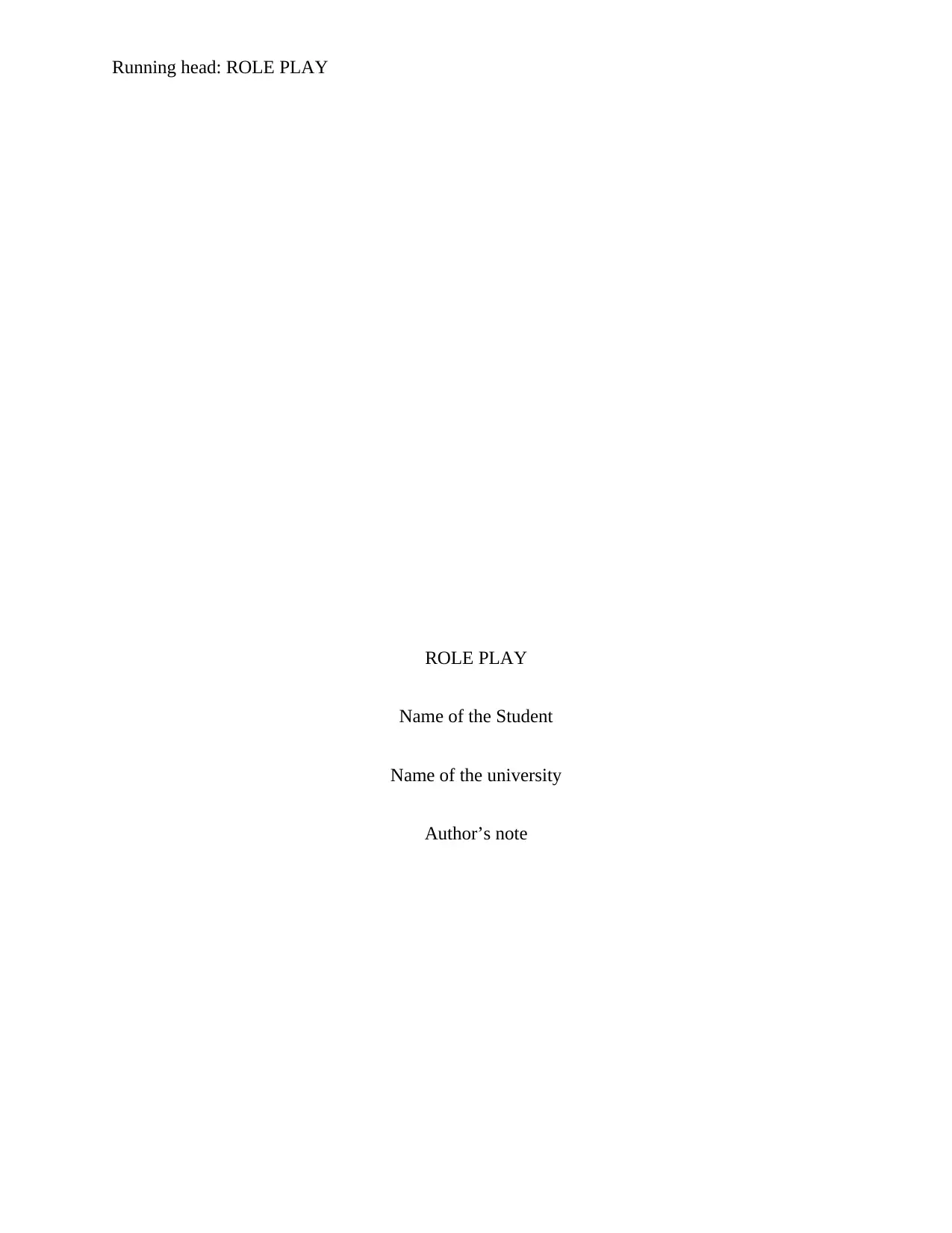
Running head: ROLE PLAY
ROLE PLAY
Name of the Student
Name of the university
Author’s note
ROLE PLAY
Name of the Student
Name of the university
Author’s note
Paraphrase This Document
Need a fresh take? Get an instant paraphrase of this document with our AI Paraphraser
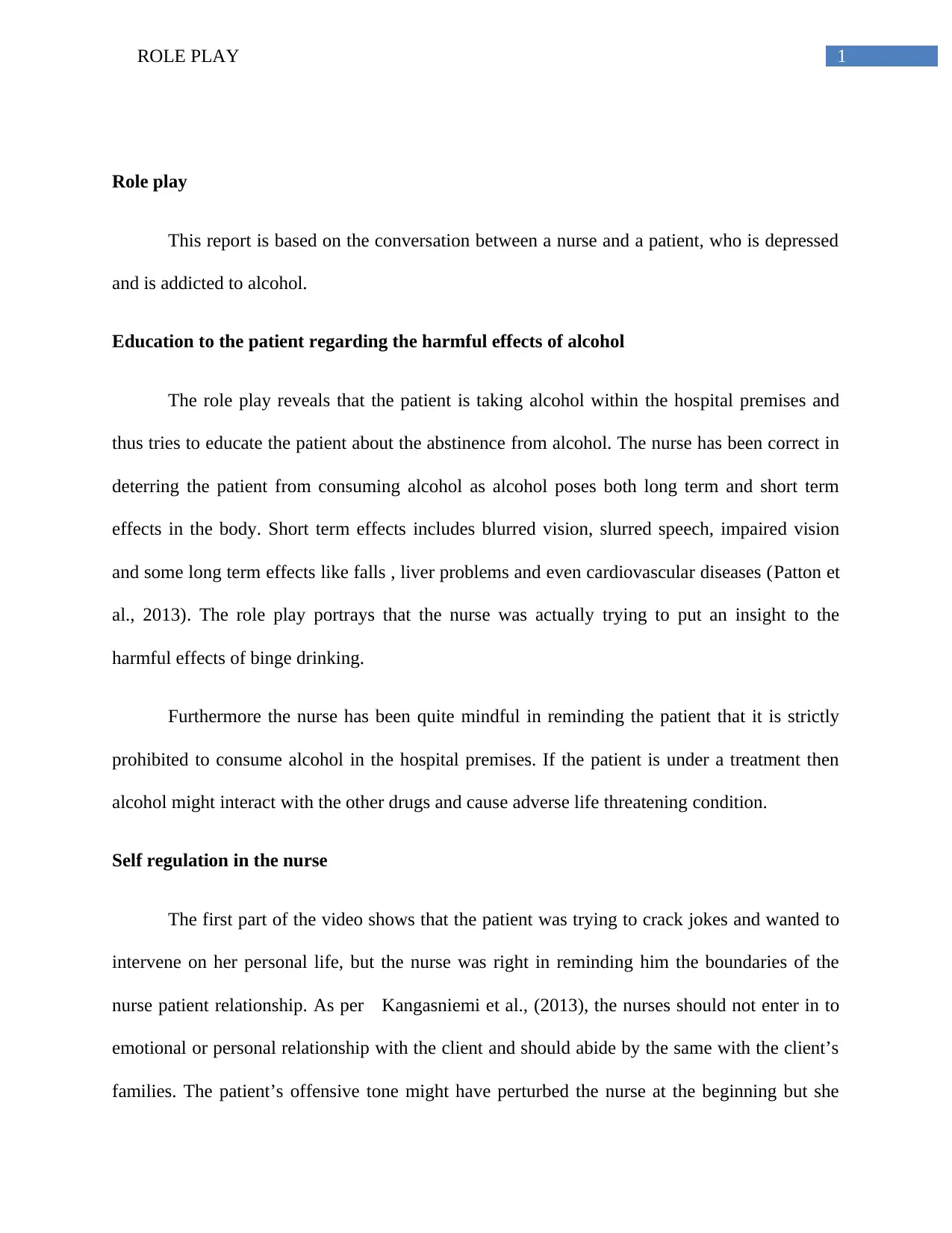
1ROLE PLAY
Role play
This report is based on the conversation between a nurse and a patient, who is depressed
and is addicted to alcohol.
Education to the patient regarding the harmful effects of alcohol
The role play reveals that the patient is taking alcohol within the hospital premises and
thus tries to educate the patient about the abstinence from alcohol. The nurse has been correct in
deterring the patient from consuming alcohol as alcohol poses both long term and short term
effects in the body. Short term effects includes blurred vision, slurred speech, impaired vision
and some long term effects like falls , liver problems and even cardiovascular diseases (Patton et
al., 2013). The role play portrays that the nurse was actually trying to put an insight to the
harmful effects of binge drinking.
Furthermore the nurse has been quite mindful in reminding the patient that it is strictly
prohibited to consume alcohol in the hospital premises. If the patient is under a treatment then
alcohol might interact with the other drugs and cause adverse life threatening condition.
Self regulation in the nurse
The first part of the video shows that the patient was trying to crack jokes and wanted to
intervene on her personal life, but the nurse was right in reminding him the boundaries of the
nurse patient relationship. As per Kangasniemi et al., (2013), the nurses should not enter in to
emotional or personal relationship with the client and should abide by the same with the client’s
families. The patient’s offensive tone might have perturbed the nurse at the beginning but she
Role play
This report is based on the conversation between a nurse and a patient, who is depressed
and is addicted to alcohol.
Education to the patient regarding the harmful effects of alcohol
The role play reveals that the patient is taking alcohol within the hospital premises and
thus tries to educate the patient about the abstinence from alcohol. The nurse has been correct in
deterring the patient from consuming alcohol as alcohol poses both long term and short term
effects in the body. Short term effects includes blurred vision, slurred speech, impaired vision
and some long term effects like falls , liver problems and even cardiovascular diseases (Patton et
al., 2013). The role play portrays that the nurse was actually trying to put an insight to the
harmful effects of binge drinking.
Furthermore the nurse has been quite mindful in reminding the patient that it is strictly
prohibited to consume alcohol in the hospital premises. If the patient is under a treatment then
alcohol might interact with the other drugs and cause adverse life threatening condition.
Self regulation in the nurse
The first part of the video shows that the patient was trying to crack jokes and wanted to
intervene on her personal life, but the nurse was right in reminding him the boundaries of the
nurse patient relationship. As per Kangasniemi et al., (2013), the nurses should not enter in to
emotional or personal relationship with the client and should abide by the same with the client’s
families. The patient’s offensive tone might have perturbed the nurse at the beginning but she
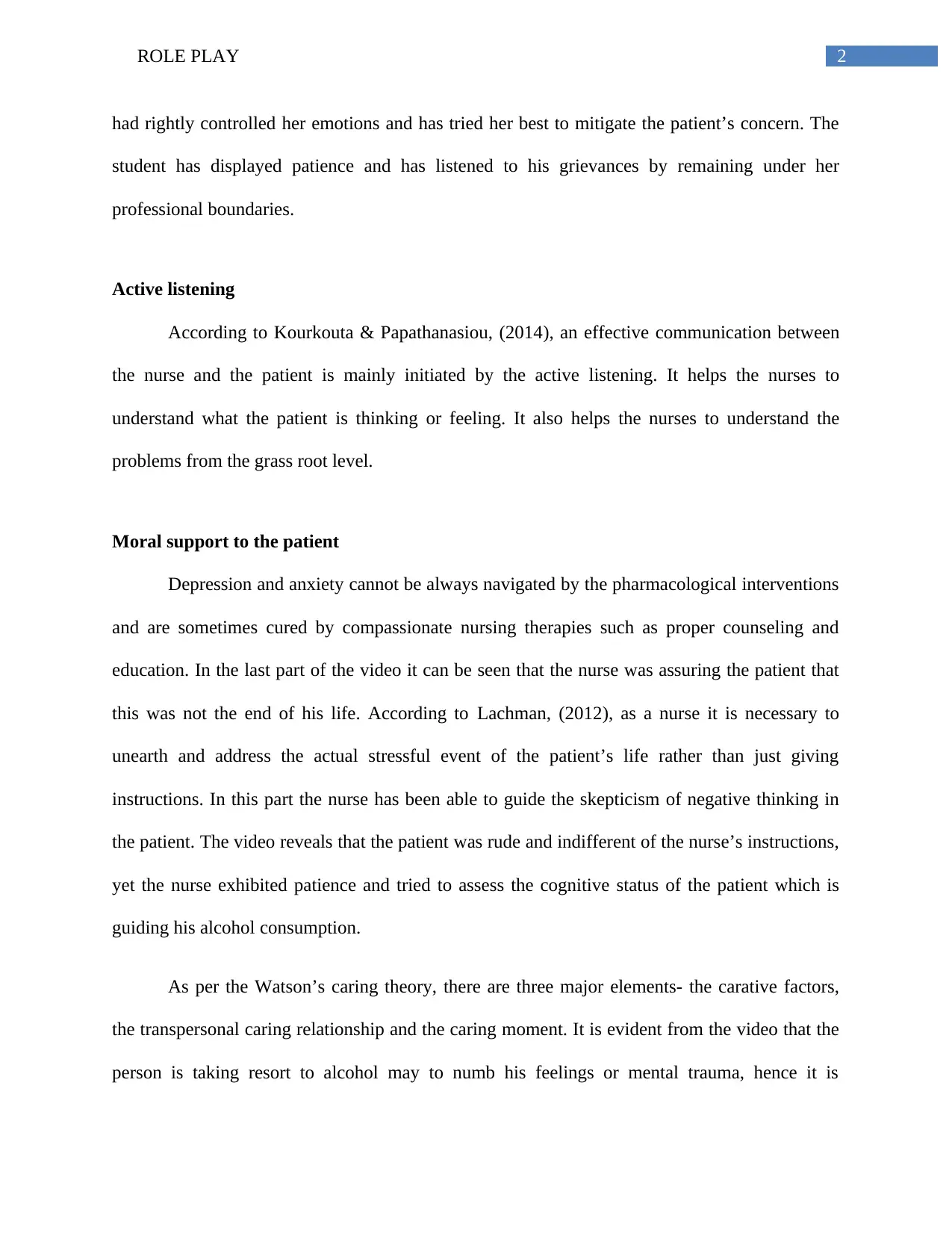
2ROLE PLAY
had rightly controlled her emotions and has tried her best to mitigate the patient’s concern. The
student has displayed patience and has listened to his grievances by remaining under her
professional boundaries.
Active listening
According to Kourkouta & Papathanasiou, (2014), an effective communication between
the nurse and the patient is mainly initiated by the active listening. It helps the nurses to
understand what the patient is thinking or feeling. It also helps the nurses to understand the
problems from the grass root level.
Moral support to the patient
Depression and anxiety cannot be always navigated by the pharmacological interventions
and are sometimes cured by compassionate nursing therapies such as proper counseling and
education. In the last part of the video it can be seen that the nurse was assuring the patient that
this was not the end of his life. According to Lachman, (2012), as a nurse it is necessary to
unearth and address the actual stressful event of the patient’s life rather than just giving
instructions. In this part the nurse has been able to guide the skepticism of negative thinking in
the patient. The video reveals that the patient was rude and indifferent of the nurse’s instructions,
yet the nurse exhibited patience and tried to assess the cognitive status of the patient which is
guiding his alcohol consumption.
As per the Watson’s caring theory, there are three major elements- the carative factors,
the transpersonal caring relationship and the caring moment. It is evident from the video that the
person is taking resort to alcohol may to numb his feelings or mental trauma, hence it is
had rightly controlled her emotions and has tried her best to mitigate the patient’s concern. The
student has displayed patience and has listened to his grievances by remaining under her
professional boundaries.
Active listening
According to Kourkouta & Papathanasiou, (2014), an effective communication between
the nurse and the patient is mainly initiated by the active listening. It helps the nurses to
understand what the patient is thinking or feeling. It also helps the nurses to understand the
problems from the grass root level.
Moral support to the patient
Depression and anxiety cannot be always navigated by the pharmacological interventions
and are sometimes cured by compassionate nursing therapies such as proper counseling and
education. In the last part of the video it can be seen that the nurse was assuring the patient that
this was not the end of his life. According to Lachman, (2012), as a nurse it is necessary to
unearth and address the actual stressful event of the patient’s life rather than just giving
instructions. In this part the nurse has been able to guide the skepticism of negative thinking in
the patient. The video reveals that the patient was rude and indifferent of the nurse’s instructions,
yet the nurse exhibited patience and tried to assess the cognitive status of the patient which is
guiding his alcohol consumption.
As per the Watson’s caring theory, there are three major elements- the carative factors,
the transpersonal caring relationship and the caring moment. It is evident from the video that the
person is taking resort to alcohol may to numb his feelings or mental trauma, hence it is
⊘ This is a preview!⊘
Do you want full access?
Subscribe today to unlock all pages.

Trusted by 1+ million students worldwide
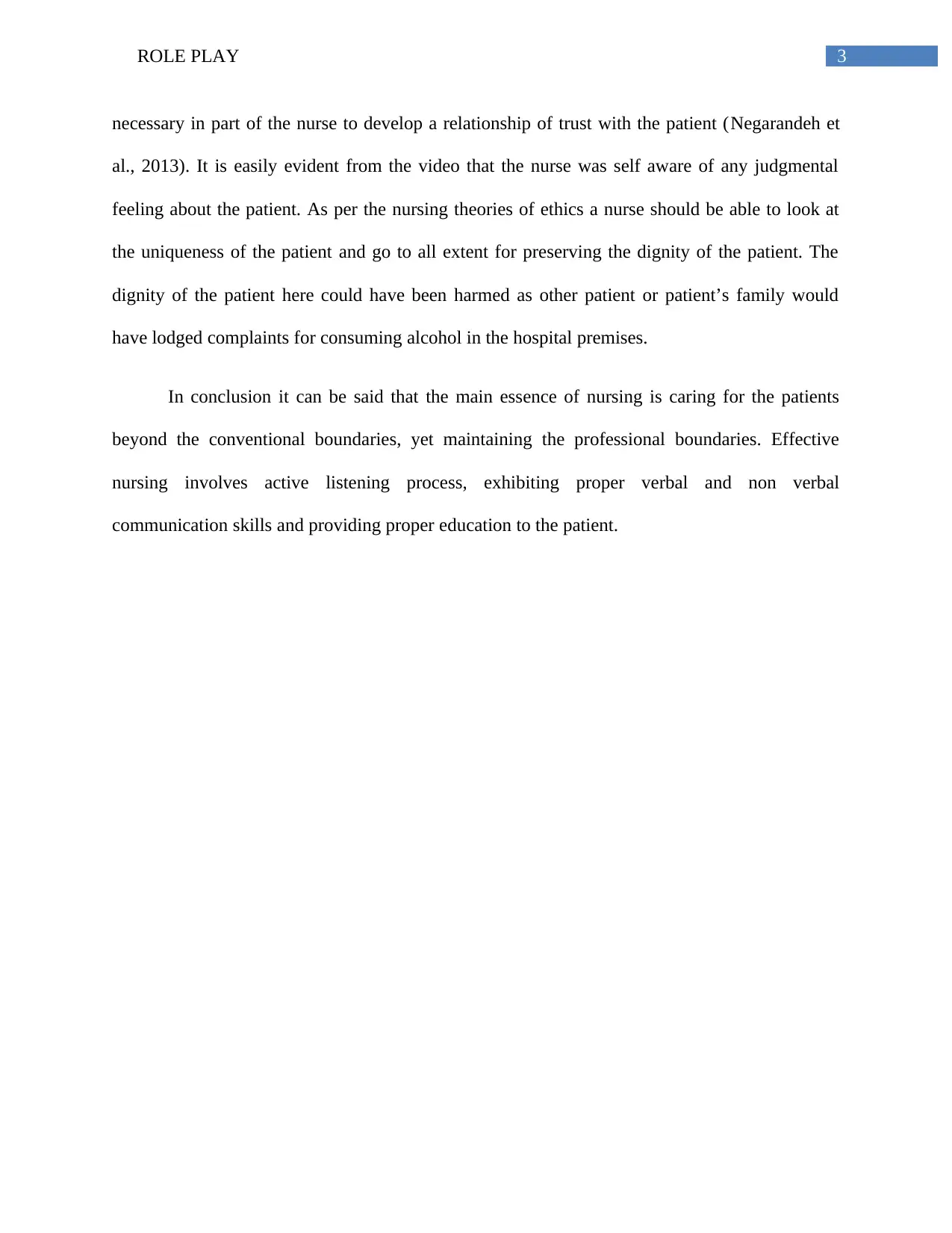
3ROLE PLAY
necessary in part of the nurse to develop a relationship of trust with the patient (Negarandeh et
al., 2013). It is easily evident from the video that the nurse was self aware of any judgmental
feeling about the patient. As per the nursing theories of ethics a nurse should be able to look at
the uniqueness of the patient and go to all extent for preserving the dignity of the patient. The
dignity of the patient here could have been harmed as other patient or patient’s family would
have lodged complaints for consuming alcohol in the hospital premises.
In conclusion it can be said that the main essence of nursing is caring for the patients
beyond the conventional boundaries, yet maintaining the professional boundaries. Effective
nursing involves active listening process, exhibiting proper verbal and non verbal
communication skills and providing proper education to the patient.
necessary in part of the nurse to develop a relationship of trust with the patient (Negarandeh et
al., 2013). It is easily evident from the video that the nurse was self aware of any judgmental
feeling about the patient. As per the nursing theories of ethics a nurse should be able to look at
the uniqueness of the patient and go to all extent for preserving the dignity of the patient. The
dignity of the patient here could have been harmed as other patient or patient’s family would
have lodged complaints for consuming alcohol in the hospital premises.
In conclusion it can be said that the main essence of nursing is caring for the patients
beyond the conventional boundaries, yet maintaining the professional boundaries. Effective
nursing involves active listening process, exhibiting proper verbal and non verbal
communication skills and providing proper education to the patient.
Paraphrase This Document
Need a fresh take? Get an instant paraphrase of this document with our AI Paraphraser
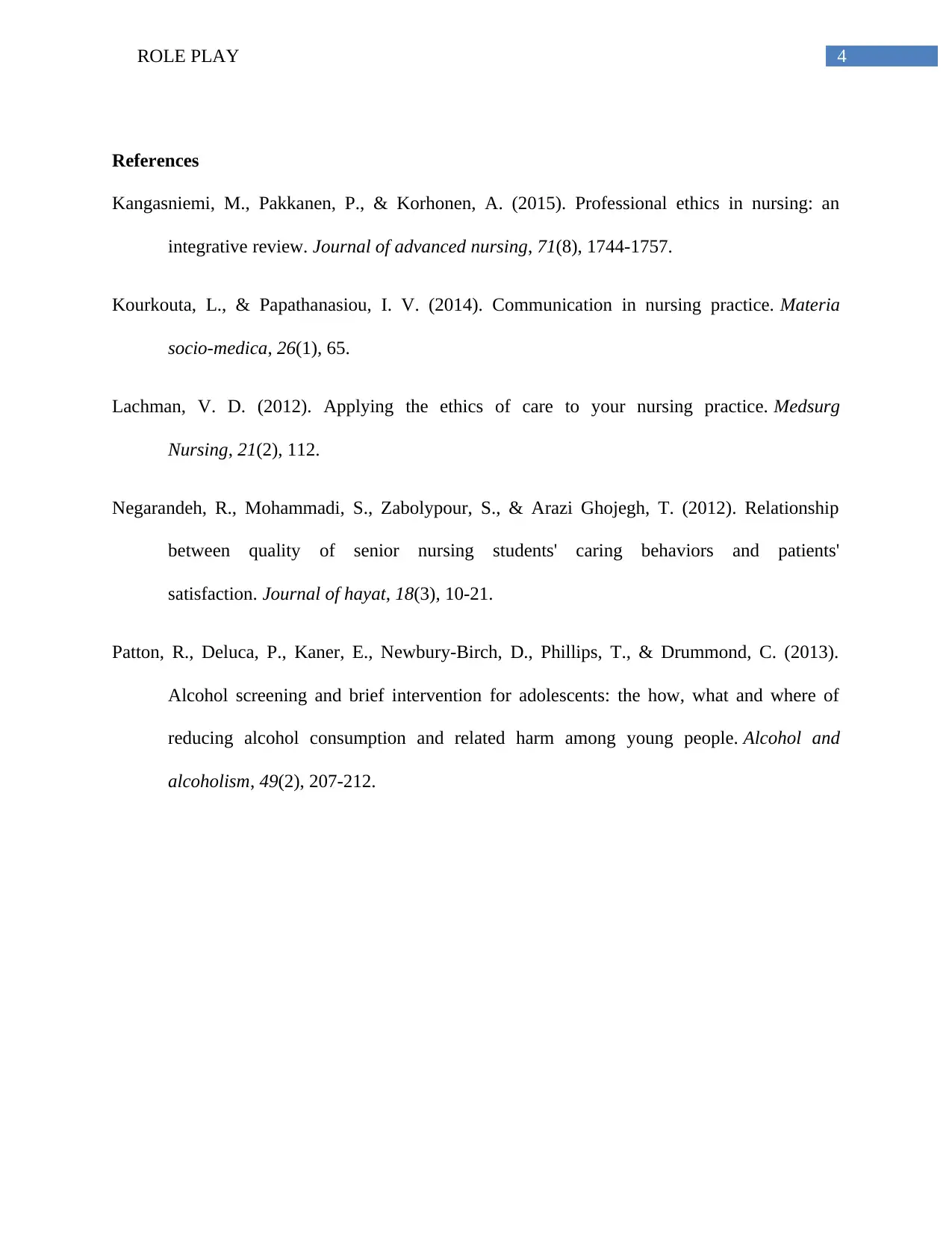
4ROLE PLAY
References
Kangasniemi, M., Pakkanen, P., & Korhonen, A. (2015). Professional ethics in nursing: an
integrative review. Journal of advanced nursing, 71(8), 1744-1757.
Kourkouta, L., & Papathanasiou, I. V. (2014). Communication in nursing practice. Materia
socio-medica, 26(1), 65.
Lachman, V. D. (2012). Applying the ethics of care to your nursing practice. Medsurg
Nursing, 21(2), 112.
Negarandeh, R., Mohammadi, S., Zabolypour, S., & Arazi Ghojegh, T. (2012). Relationship
between quality of senior nursing students' caring behaviors and patients'
satisfaction. Journal of hayat, 18(3), 10-21.
Patton, R., Deluca, P., Kaner, E., Newbury-Birch, D., Phillips, T., & Drummond, C. (2013).
Alcohol screening and brief intervention for adolescents: the how, what and where of
reducing alcohol consumption and related harm among young people. Alcohol and
alcoholism, 49(2), 207-212.
References
Kangasniemi, M., Pakkanen, P., & Korhonen, A. (2015). Professional ethics in nursing: an
integrative review. Journal of advanced nursing, 71(8), 1744-1757.
Kourkouta, L., & Papathanasiou, I. V. (2014). Communication in nursing practice. Materia
socio-medica, 26(1), 65.
Lachman, V. D. (2012). Applying the ethics of care to your nursing practice. Medsurg
Nursing, 21(2), 112.
Negarandeh, R., Mohammadi, S., Zabolypour, S., & Arazi Ghojegh, T. (2012). Relationship
between quality of senior nursing students' caring behaviors and patients'
satisfaction. Journal of hayat, 18(3), 10-21.
Patton, R., Deluca, P., Kaner, E., Newbury-Birch, D., Phillips, T., & Drummond, C. (2013).
Alcohol screening and brief intervention for adolescents: the how, what and where of
reducing alcohol consumption and related harm among young people. Alcohol and
alcoholism, 49(2), 207-212.
1 out of 5
Related Documents
Your All-in-One AI-Powered Toolkit for Academic Success.
+13062052269
info@desklib.com
Available 24*7 on WhatsApp / Email
![[object Object]](/_next/static/media/star-bottom.7253800d.svg)
Unlock your academic potential
Copyright © 2020–2025 A2Z Services. All Rights Reserved. Developed and managed by ZUCOL.





